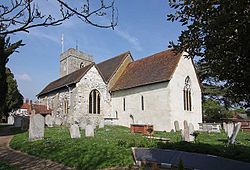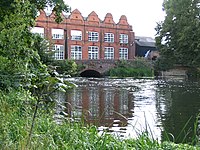Old Woking
| Old Woking | |
| Surrey | |
|---|---|
 St Peters Church, Old Woking | |
| Location | |
| Grid reference: | TQ016566 |
| Location: | 51°18’1"N, 0°32’37"W |
| Data | |
| Population: | 3,192 (2011) |
| Post town: | Woking |
| Postcode: | GU22 |
| Dialling code: | 01483 |
| Local Government | |
| Council: | Woking |
| Parliamentary constituency: |
Woking |
Old Woking is a village in Surrey, on the bank of the River Wey at the southern edge of the modern town of Woking. This is in the original Woking: the town grew up from the Victorian era, and the original village became known as 'Old Woking'. It is about a mile and a half south-east of the modern town centre.
The village has a relatively short east-west thoroughfare, the High Street and very short Church Street, on which stands the parish church, surrounded by a cluster of 17th and 18th centuries buildings around the small conservation area.
Old Woking is bounded by the Hoe Stream to the north and the River Wey to the south and between Kingfield to the west and farmland to the east. Its main road is the A247, which connects Woking with Clandon Park and provides access to the A3. The village contains parts of Woking's two largest parks and two converted paper mills. The expanded village largely consists of semi-detached houses with gardens and covers an area of 554 acres
To the east of Old Woking's developed cluster are the ruins of Woking Palace which was the local manor house and a royal dwelling throughout the Tudor dynasty.
Contents
Parish church
The Church of England parish church is St Peter’s. It is a Grade I listed building, dating from the 12th century.[1]
The west door of the church is the oldest door in Surrey and probably the third oldest in the country having been dated by dendrochronology to the reign of Henry I (1100–35). The four planks making up the door very likely came from a single tree which was over 270 years old when it was felled, so the tree must have grown from an acorn which germinated in the reign of King Egbert of Wessex (802–39). Dr Jane Geddes, of the University of Aberdeen, has identified the door as one of only five picture doors in the country and the ironwork as mediæval.[2]
History
The village of Old Woking, though much rebuilt, predates the rest of Woking by over 1,000 years and still contains many historic buildings; the Old Wokings Residents' Association architectural group has recorded over 100 buildings in St Peter's parish built before 1700. More than 50 buildings are listed buildings.[3]
The church is of the 12th century. Other significant buildings in the parish include Ye Olde Brew House, The Grange, London House, Sutton Place, Church Cottage, Hand and Spear, The Old House, The Old Vicarage, Fishers Farm, Hoe Place, The Old Manor House and Weylea.[3]
Manor
In the Middle Ages, Woking Palace stood here; nationally prominent as it was as a main home of Margaret Beaufort, the pious and determined mother of Henry VII.[4] It remained a royal residence throughout the Tudor period. However after Margaret's death it lost importance compared to the royal palaces of London, Oatlands Palace[5] and Windsor Castle.[5]
By 1911 only the foundations, stumps of walls and earthworks remained. These still provide visitors with evidence of its once extensive buildings, with two chapels, within a double moat. The double moat is shown in the survey by Norden of 1607, and the remains of what was the manor house are still visible at Woking Park Farm. The palace had a cornmill, a fulling-mill and a deer park.[5]
King James VI and I made a grant of the estate in 1620 to Sir Edward Zouch, who died in 1634. In 1715 following that family, the palace in some ruin already, and the vast manor estate around it was bought by John Walter. His son Abel sold it to Lord Onslow in 1752 in whose hands Old Woking remained until the Earls sold it off piecemeal, through the 19th and 20th centuries.[5]
After the Industrial Revolution
For most of the 20th Century and earlier Old Woking was the commercial hub of Woking containing many large companies including the original factory of Kenwood Limited, manufacturer of kitchen appliances, notably the Kenwood Chef. Today the company is owned by DeLonghi. Harvey's Water Softeners is another example of a long-established manufacturing business in the area.[6]
The village had a substantial automotive sector, specifically in repair and retail. Since the 1990s most industry, storage and assembling operations have declined in the village. Thames Water's treatment works to the east of the village have expanded in line with population.[7] The main sites of the James Walker factory and the Gresham Press operated from the 1890s[5] until the late 20th century. The printing works utilised two paper mills on the Wey. Both have been redeveloped into upmarket apartments.
Around and about he village
Mill Moor, directly south of the High Street, is a nature reserve criss-crossed by paths. It has been denoted a Site of Nature Conservation Interest.
To the north there are two nature reserves along the Hoe Stream, the White Rose Lane Nature Reserve, an area of alder woodlands, and the Mayford Meadows wetland habitat.[8]
Surrounded by narrow channels which are branches of the River Wey, this imposing red-brick, tall lattice windowed former paper mill with red stone renderings has been converted to apartments and houses.
This offshoot of the same printing works on the River Wey's backwater streams, Gresham's Mill, has also been converted to large apartments and houses; its façade is in light brick, set behind trees, with a stylistic multi-hipped, gable-end roof. The mill race has been adapted to drive a hydro-electric turbine to generate electricity for the development.[9]
Pictures
| ("Wikimedia Commons" has material about Old Woking) |
Outside links
References
- ↑ National Heritage List 1044724: St Peter's Church (Grade I listing)
- ↑ Geddes, Jane (1999). Mediæval Decorative Ironwork in England. London: Society of Antiquaries of London. ISBN 9780854312733. https://books.google.com/books/about/Mediæval_decorative_ironwork_in_England.html?id=rDdnAAAAMAAJ. Retrieved 16 January 2013.
- ↑ 3.0 3.1 Old Woking Village Association
- ↑ Woking Palace
- ↑ 5.0 5.1 5.2 5.3 5.4 A History of the County of Surrey - Volume 3 pp 381-390: Parishes: Woking (Victoria County History)
- ↑ Harvey's Water Softeners. Retrieved 6 November 2013
- ↑ Location of STWs Thames Water. Retrieved 6 November 2013
- ↑ "Woking Local Nature Reserves". https://www.surreycc.gov.uk/culture-and-leisure/countryside/what-to-see/nature-and-wildlife/woking.
- ↑ "Gresham Mills". http://www.jtp.co.uk/projects/gresham-mill.





